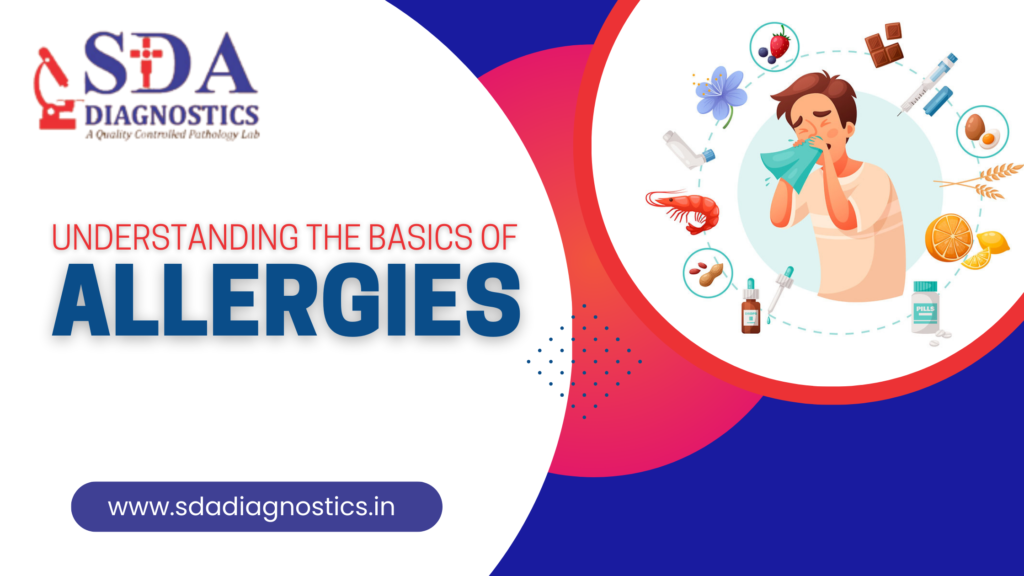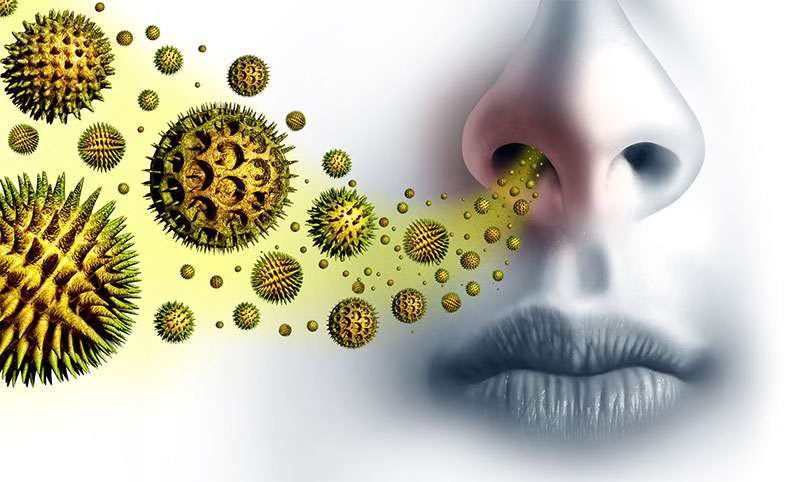Understanding the Basics of Allergies

Welcome to the “Understanding the Basics of Allergies” blog series brought to you by SDA Diagnostics. In this comprehensive series, we delve into the intricate world of allergies, shedding light on their nature, history, and common misconceptions.
What are Allergies?
Allergies are complex immune responses triggered by substances that are typically harmless to most people. These substances, known as allergens, can range from pollen and pet dander to certain foods and medications. Understanding the mechanisms behind allergies is crucial in managing and mitigating their effects on individuals.
History of Allergies
The history of allergies is rich and varied, dating back centuries. From ancient texts documenting reactions to bee stings to modern scientific advancements uncovering the intricacies of allergic reactions, tracing the evolution of our understanding of allergies offers valuable insights into their diagnosis, treatment, and prevention.
Types of Allergies
A. Environmental Allergies
It stem from substances found in the environment. These allergens can trigger immune responses when inhaled, ingested, or come into contact with the skin.
1. Pollen Allergies
It, also known as hay fever or allergic rhinitis, occur when the immune system reacts to pollen from trees, grasses, and weeds. Symptoms often include sneezing, congestion, and itchy or watery eyes.
2. Dust Mite Allergies
Dust mites are tiny organisms found in household dust. Allergic reactions to dust mites can manifest as asthma symptoms or allergic rhinitis. Common symptoms include wheezing, coughing, and nasal congestion.
3. Animal Allergies
It is triggered by proteins found in the skin cells, saliva, or urine of animals such as cats, dogs, and rodents. Exposure to these allergens can result in symptoms ranging from sneezing and nasal congestion to skin rashes and asthma attacks.

B. Food Allergies
It occur when the immune system reacts abnormally to certain proteins found in food. Unlike food intolerances, which typically involve digestive symptoms, food allergies involve an immune response.
1. Common Food Allergens
Some of the most common food allergens include peanuts, tree nuts, milk, eggs, soy, wheat, fish, and shellfish. These allergens can elicit a range of reactions from mild itching and hives to severe anaphylaxis.
2. Symptoms of Food Allergies
Symptoms of food allergies can vary widely and may affect different parts of the body. Common symptoms include hives, swelling of the lips or face, gastrointestinal discomfort, and difficulty breathing.
3. Diagnosing Food Allergies
Diagnosing food allergies often involves a combination of medical history, physical examination, and diagnostic tests such as skin prick tests or blood tests. Oral food challenges may also be conducted under medical supervision to confirm or rule out food allergies.

C. Skin Allergies
It manifest as allergic reactions on the skin, resulting from direct contact with allergens.
1. Contact Dermatitis
Contact dermatitis occurs when the skin comes into direct contact with an allergen or irritant, leading to redness, itching, and inflammation. Common triggers include certain metals, cosmetics, and latex.
2. Eczema
Eczema, also known as atopic dermatitis, is a chronic skin condition characterized by dry, itchy, and inflamed skin. While the exact cause of eczema is unknown, it is believed to involve a combination of genetic and environmental factors.
3. Hives
Hives, or urticaria, are raised, red welts on the skin that often itch and can appear suddenly. Allergic reactions to foods, medications, insect stings, or environmental factors can trigger hives.
Understanding the various types of allergies and their associated triggers is essential for effective management and treatment. If you suspect you have allergies, consult with a healthcare professional for proper diagnosis and guidance.
Causes of Allergies
A. Genetic Factors
Genetic predisposition plays a significant role in the development of allergies. Individuals with a family history of allergies are more likely to develop allergic reactions themselves. Specific genetic variations can influence how the immune system responds to allergens, making certain individuals more susceptible to allergic conditions such as asthma, allergic rhinitis, or atopic dermatitis.
B. Environmental Factors
Environmental factors encompass a wide range of external elements that can trigger allergic reactions. These may include exposure to allergens such as pollen, dust mites, pet dander, mold spores, and certain foods. Additionally, pollution, climate changes, and geographical location can influence the prevalence and severity of allergies. Environmental factors can interact with genetic predispositions to increase the likelihood of developing allergies.
C. Lifestyle Factors
Lifestyle choices and behaviors can also contribute to the development or exacerbation of allergies. Factors such as diet, hygiene practices, and exposure to tobacco smoke or other pollutants can influence immune system function and increase susceptibility to allergic reactions. Changes in lifestyle patterns, such as dietary modifications, adoption of pets, or exposure to new environments, may introduce new allergens or exacerbate existing allergic conditions.
Common Symptoms of Allergies
Sneezing: Allergic reactions often trigger bouts of sneezing, especially in response to exposure to allergens such as pollen, dust mites, or pet dander.
Nasal Congestion: Allergies can cause inflammation of the nasal passages, leading to congestion or a stuffy nose.
Runny or Itchy Nose: Excessive nasal discharge or itching is a common symptom of allergic rhinitis, commonly known as hay fever.
Itchy or Watery Eyes: Allergic reactions can cause irritation and inflammation of the eyes, resulting in itching, redness, and excessive tearing.
Coughing: Allergies can irritate the airways, leading to coughing, especially in individuals with allergic asthma.
Wheezing: Asthma, a common allergic condition, can cause narrowing of the airways, resulting in wheezing or difficulty breathing.
Shortness of Breath: Severe allergic reactions, such as anaphylaxis, can cause constriction of the airways, leading to difficulty breathing and shortness of breath.
Itchy Skin: Allergic reactions can manifest as itching or pruritus, often accompanied by redness or inflammation of the skin.
Hives: Raised, red welts or bumps on the skin, known as hives or urticaria, can develop as a result of exposure to allergens.
Eczema: Atopic dermatitis, a chronic skin condition associated with allergies, can cause dry, itchy, and inflamed patches of skin.
Nausea or Vomiting: Some individuals may experience gastrointestinal symptoms such as nausea or vomiting in response to food allergens.
Abdominal Pain or Cramps: Allergic reactions to certain foods or substances can cause abdominal discomfort, pain, or cramping.
Diarrhea: In severe cases of food allergies or allergic reactions, diarrhea may occur as the body attempts to expel allergens from the digestive system.
Diagnosis of Allergies
Skin Prick Test:
The skin prick test, also known as a puncture or scratch test, is a common method used to identify allergens that trigger allergic reactions. During this test, a small amount of suspected allergens, such as pollen, dust mites, pet dander, or specific foods, are applied to the skin, usually on the forearm or back. The skin is then pricked or scratched to allow the allergen to enter the skin’s surface. If an individual is allergic to a particular substance, a reaction, such as redness, swelling, or itching, will occur within 15 to 20 minutes. The size of the reaction helps determine the severity of the allergy.
Blood Test:
Blood tests, such as the specific IgE blood test (immunoglobulin E), measure the levels of IgE antibodies present in the blood in response to specific allergens. IgE antibodies are produced by the immune system when it encounters allergens. A blood sample is taken from the individual and sent to a laboratory for analysis. The results indicate the presence and levels of IgE antibodies associated with various allergens, helping to identify specific allergens that may be causing allergic reactions. Blood tests are particularly useful for individuals who cannot undergo skin prick tests due to skin conditions or medication use.
Elimination Diet:
An elimination diet involves systematically removing certain foods or food groups from the diet and then reintroducing them one at a time while monitoring for allergic reactions. This method is primarily used to identify food allergies or sensitivities. Individuals may keep a food diary to track symptoms and identify potential triggers. After eliminating common allergens, such as dairy, eggs, wheat, soy, nuts, and seafood, from the diet for a period of time (usually two to four weeks), foods are reintroduced one at a time. If an allergic reaction occurs after reintroducing a specific food, it may indicate an allergy or sensitivity to that food.
Conclusion:
Understanding allergies is essential for effectively managing and mitigating their impact on individuals’ health and well-being. By recognizing the triggers, symptoms, and treatment options for it, individuals can take proactive steps to minimize exposure to allergens and alleviate symptoms. Education about it not only empowers individuals to make informed decisions about their health but also promotes awareness and understanding within communities. Tips for living with it include maintaining a clean indoor environment, avoiding known allergens, carrying emergency medication (such as epinephrine for severe allergic reactions), and seeking medical advice for proper diagnosis and treatment. Additionally, resources such as healthcare professionals, allergy clinics, support groups, and reputable websites provide valuable information and support for individuals and families affected by allergies. By accessing reliable resources and building a support network, individuals can navigate the challenges of living with allergies more effectively and improve their quality of life.
FAQs:
Can allergies develop later in life?
Yes, It can develop at any age, even in adulthood. While some individuals may experience allergies from childhood, others may develop allergies later in life due to changes in the immune system, environmental factors, or exposure to new allergens. It’s essential to be aware of the signs and symptoms of allergies and consult with a healthcare professional for proper diagnosis and treatment if allergic reactions occur.
Yes, allergies can have a hereditary component. Individuals with a family history of allergies are more likely to develop allergic reactions themselves. Specific genetic variations can influence how the immune system responds to allergens, making certain individuals more susceptible to allergic conditions such as asthma, allergic rhinitis, or atopic dermatitis. However, not everyone with a family history of allergies will develop allergic reactions, and environmental factors also play a significant role in allergy development.
Is there a cure for allergies?
While there is currently no cure for allergies, various treatments and management strategies are available to alleviate symptoms and improve quality of life. These may include allergen avoidance, medications such as antihistamines or corticosteroids to reduce symptoms, allergen immunotherapy (allergy shots) to desensitize the immune system, and lifestyle modifications. The most suitable treatment approach depends on the type and severity of allergies, as well as individual health factors. It’s essential to work with a healthcare professional to develop a personalized treatment plan tailored to your specific needs and circumstances.
